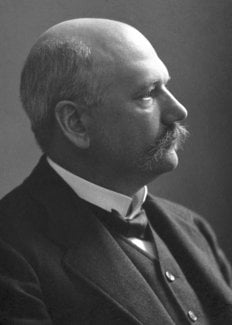Albrecht Kossel
Biographical

Ludwig Karl Martin Leonhard Albrecht Kossel was born in Rostock on September 16, 1853. He was the eldest son of the merchant and Prussian consul Albrecht Kossel and his wife Clara, née Jeppe. He attended the secondary school in Rostock and went, in the autumn of 1872, to the newly founded University of Strassburg in order to study medicine. He was especially influenced by the lectures and practical teaching of de Bary, Waldeyer, Kundt, Baeyer and especially by Hoppe-Seyler.
Part of his studies were carried out in the University of his hometown Rostock where he passed in 1877 the state medical examination and in 1878 the degree of Doctor of Medicine was conferred on him. In the autumn of 1877 he took an assistantship in Hoppe-Seyler’s Institute of Physical Chemistry in Strassburg and in 1881 he qualified as Lecturer of Physiological Chemistry and Hygiene. In 1883 E. du Bois-Reymond called him to become Director of the Chemical Division of the Institute of Physiology in Berlin in place of E. Baumann who had gone to Freiburg and here, in 1887, he became Extraordinary Professor in the Medical Faculty. In April 1895 he moved to Marburg in Hessen as Ordinary Professor of Physiology and Director of the Institute of Physiology there. Here he worked until the spring of 1901. Then he was called to the Chair in Heidelberg formerly held by Kühne and before him by Helmholtz. In 1907 he was appointed «Geheimer Hofrat» (Privy Councillor) and in this year also he presided as Chairman over the Seventh International Congress of Physiology in Heidelberg. In 1908-1909 he was Prorector of this University.
Albrecht Kossel was an honorary doctor of the Universities of Cambridge, Dublin, Ghent, Greifswald, St. Andrews and Edinburgh, and a member of various Academies, among which are the Royal Swedish Academy of Sciences and the Royal Society of Sciences of Uppsala.
Kossel’s field of work was physiological chemistry, especially the chemistry of tissues and cells; his activities as a teacher in the University, however, extended to general physiology, which in his time was in most German universities still not separated from physiological chemistry. He began his investigations into the constitution of the cell nucleus at the end of the seventies, and in the nineties he turned more and more to the study of the proteins, the alterations in proteins during transformation into peptone, the effects of a phenetol diet on the urine, the peptonic components of the cells, the simplest proteins, etc. Working on fish-roe he studied the protamines and hexone bases. In 1896 he discovered histidine, then worked out the classical method for the quantitaive separation of the hexone bases. With his distinguished English pupil H. D. Dakin he investigated arginase, the ferment which hydrolyses arginine into urea and ornithine, and later he discovered agmatine in herring roe and devised a method for preparing it.
Kossel was active in securing the foundation of separate chairs of physiology and medical chemistry in German universities so that these subjects would develop. His works were published chiefly in the Zeitschrift für physiologische Chemie, which after the deaths of Hoppe-Seyler and E. Baumann came under his direction.
Among his important publications may be mentioned: Untersuchungen über die Nukleine und ihre Spaltungsprodubte (Investigations into the nucleins and their cleavage products), 1881; Die Gewebe des menschlichen Körpers und ihre mikroskopische Untersuchung (The tissues in the human body and their microscopic investigation), 1889-1891, in two volumes, with Behrens and Schieerdecker; and the Leitfaden für medizinisch-chemische Kurse (Textbook for medical-chemical courses), 1888, since reprinted several times. He was also the author of Die Probleme der Biochemie (The problems of biochemistry), 1908; Die Beziehungen der Chemie zur Physiologie (The relationships between chemistry and physiology), which was a contribution to Kultur der Gegenwart, 1913.
Kossel had one daughter and one son, Walther (1888-1956), who became a prominent Professor of Theoretical Physics at Kiel until he moved to the corresponding position at the Danzig Institute of Technology (1932-1945), and in 1947 became Professor at Tübingen University.
Albrecht Kossel died on July 5, 1927.
This autobiography/biography was written at the time of the award and first published in the book series Les Prix Nobel. It was later edited and republished in Nobel Lectures. To cite this document, always state the source as shown above.
The Nobel Foundation's copyright has expired.Nobel Prizes and laureates
Six prizes were awarded for achievements that have conferred the greatest benefit to humankind. The 12 laureates' work and discoveries range from proteins' structures and machine learning to fighting for a world free of nuclear weapons.
See them all presented here.
